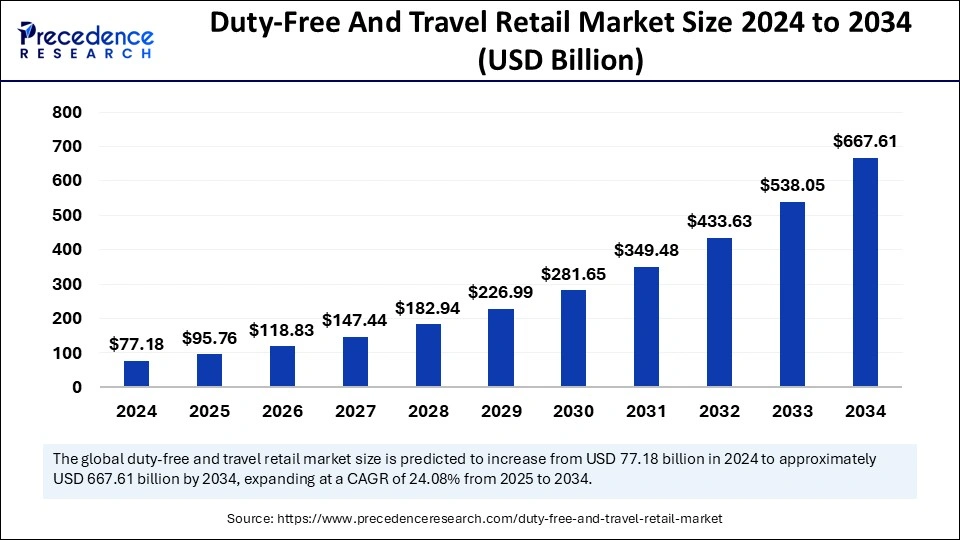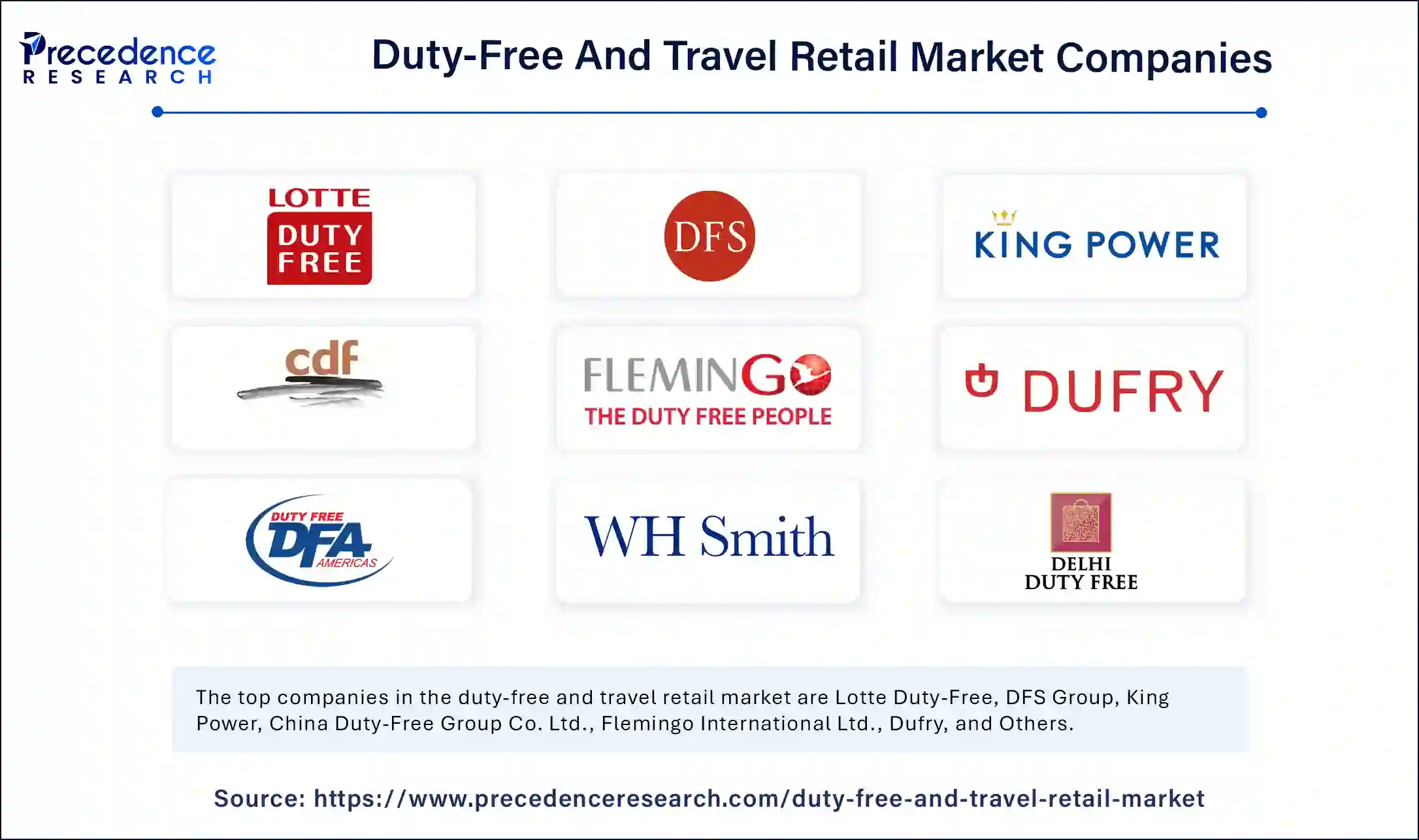March 2025
The global duty-free and travel retail market size is calculated at 95.76 billion in 2025 and is forecasted to reach around USD 667.61 billion by 2034, accelerating at a CAGR of 24.08% from 2025 to 2034. The market sizing and forecasts are revenue-based (USD Million/Billion), with 2024 as the base year.
The global duty-free and travel retail market size accounted for USD 77.18 billion in 2024 and is predicted to increase from USD 95.76 billion in 2025 to approximately USD 667.61 billion by 2034, expanding at a CAGR of 24.08% from 2025 to 2034. The global shift towards excellent travel experiences and duty-free purchase of goods drives the growth of the duty-free and travel retail market.

The duty-free and travel retail market revolves around the sale of goods to international travelers. The duty-free sales are conducted in a highly regulated retail environment which drives the significance of the market globally. These services are governed by custom allowances such as airports, ferries, ports, etc. The operations within this industry are governed by national customs authorities. Some of the destination airports of Europe, Australia, the Middle East, and Latin America allow their travelers to buy duty-free goods on their arrival. These initiatives generally become an important source of revenue for destination airports. In March 2025, the Public Investment Fund (PIF) in Saudi Arabia announced the establishment of a duty-free company named AI Waha which is a travel retailer and the first duty-free operator in Saudi Arabia.
The adoption of artificial intelligence by travel retail stakeholders helps to drive a seamless customer experience. AI technology enhances the quality of customer experiences, optimizes operations, and boosts the efficiency of businesses. AI also provides personalized recommendations, manages efficient inventory management, and improves fraud detection. AI algorithms can analyze customer data to recommend personalized products or give product recommendations. AI-powered robots provide better customer service while AI-powered mirrors and body scanners help customers try new products.
| Report Coverage | Details |
| Market Size by 2034 | USD 667.61 Billion |
| Market Size in 2025 | USD 95.76 Billion |
| Market Size in 2024 | USD 77.18 Billion |
| Market Growth Rate from 2025 to 2034 | CAGR of 24.08% |
| Dominated Region | Asia Pacific |
| Fastest Growing Market | Europe |
| Base Year | 2024 |
| Forecast Period | 2025 to 2034 |
| Segments Covered | Product Type, Distribution Channel, and Regions |
| Regions Covered | North America, Europe, Asia-Pacific, Latin America and Middle East & Africa |
Optimized Digital Technology Solutions
The improved connectivity, well-established infrastructure, and great travel affordability stand as the principal drivers of the duty-free and travel retail market. The accountable airport activities and the increased usage of smartphone technology to streamline travel experiences raise the successive growth of the market. The great usage of social media and streaming platforms also propels the market’s growth. The enhanced digital engagement and improved customer targeting in travel retail purchases and at airports support the market’s expansion globally.
Dynamic Nature of Travel Retail Businesses
The sensitivity of travel retail markets associated with the exchange of rates among nations creates a challenging environment. The risks associated with numerous currencies such as pounds, euros, dollars, etc. when dealing with different countries impose marketing challenges. There may be fluctuations in currency exchange and they can impact travel retail businesses in either a positive or a negative manner. The dependency of retail chains offering luxury goods on fluctuating exchange rates may create competitiveness. The various impacting factors such as economic and political conditions are responsible for fluctuating exchange rates in the global market.
Insertion of AI, AR, and e-Commerce Platforms
E-commerce platforms are increasingly adopted by global business organizations dealing with different commercial and retail sectors. The incorporation of augmented reality (AR) and AI-powered robotic assistance into travel industries helps to enhance travel experiences for potential customers. The supportive schemes, policies, discounts, and incentives by organizations and industries help to engage ideal clients towards purchasing goods and adopting related services. The growing trend of online product purchasing, online product delivery, and speedy internet services also accelerate the expansion of the duty-free and travel retail market.
By product type, the beauty and personal care segment dominated the duty-free and travel retail market in 2024 due to remarkable growth in sales of cosmetics and perfumes among the Asia Pacific regional travelers. The increased need for natural and organic personal care products by potential customers in the APAC region also propels segmental growth in the market. Moreover, the growing concerns about the toxic effects of chemical products among the population raised the need for sustainable product manufacturing and supply. The adoption of new trends for making cosmetic products as brands in the industry drives the expansion of products. The insertion of augmented reality (AR) for face and skin mapping supports the shift of customers towards virtual acceptance of products before in-person visits to stores. The increased convenience of buying products is accelerated by the less time-consuming steps due to technological advancements.
By product type, the fashion accessories and hard luxury segment is expected to grow at the fastest rate in the duty-free and travel retail market during the forecast period. The acceptance of a welcoming atmosphere and premium brands at airports drives the growth of this segment significantly. The presence of modern and brand-conscious consumers raised the demand for excellent customer service. The preference for the best goods from luxury brands and the enjoyment of the purchasing process drive segmental progress. The efforts of travel shops to understand customer requirements and identify changes in customer behavior also boost segmental growth in the market. The availability of the most recent collections at travel retail stores with luxury labels helps to enlarge their customers.
By distribution channel, the airports segment led the duty-free and travel retail market in 2024 due to a growing trend of duty-free shopping and other travel-associated retail services. The emerging rise of travel-related retail activities at International airports also boosts the growth of airports globally. The regular fair share of regular travelers for airport duty-free stores raised segmental progress in the market. The affordability of air travel due to low-cost carriers such as Spirit and EasyJet accelerated the success of airports. The positive attitude of people towards product advancements, facilities, and airport services aids in the successive growth of the market.
By distribution channel, the seaports segment is anticipated to be the fastest-growing in the duty-free and travel retail market during the forecast period. This segmental growth is driven by the availability of brands of various products across international markets. The developments in the seaport create favorable business opportunities for industry participants. The increasing global trade and infrastructure modernization also promote the significant growth of the seaports segment. The developments in ships and large vessels make the efficient seaports sector in the market.
Asia Pacific dominated the duty-free and travel retail market in 2024 due to the trend of outbound travel in countries like China. China holds a strong position as the largest outbound travel market associated with a large number of tourists and expenditures. The increased wages, luxurious travel visa policies, improved internet access to travel information, etc. accelerate the regional market’s growth significantly.
The huge growth of international travelers also raises the demand for Chinese duty-free consumption in the market. Technological advancements in Asian countries offer favorable opportunities for established duty-free retail stores to introduce a broad spectrum of innovative products.
Research Projects and Investments in India to Support the Market in Asia
In the Asian countries, airports are developing activities to engage travellers. These activities are becoming airport tourist attractions, experimental and entertainment zones, F&B & lounges. The rain vortex, the aviation center, the garden of light, the butterfly garden, the art gallery, cinemas, F&B outlets, airport lounges, etc. are the additional improvements made by airports.
The leading companies like Adani Enterprises (AEL) located in Ahmedabad, Gujarat hold a strong position as the leading player in India’s economic development. The increased focus of companies like AEL on mining, energy, transportation, and consumer goods drives the remarkable expansion of the market.
The significant efforts of Indian companies in operating renewable energy projects, and developing airports, roads, ports, etc. boost the market’s expansive reach throughout the nation. Moreover, the heavy investments in coal mining in India, Indonesia, and Australia also accelerate the market’s success globally. The emerging research efforts in solar manufacturing, green hydrogen, defense, and ensuring long-term sustainability uphold the market in terms of competitiveness globally.
Rapid Tourism to Support the Growth of European Market’s Growth
Europe is expected to be the fastest-growing region in the duty-free and travel retail market during the forecast period. This regional growth is driven by the presence of a strong retail channel of duty-free and travel retail that reaches up to international travelers. This market stands as a significant source of revenue and creates favorable marketing opportunities for European businesses. The notable success of DFTR channels resulting in the development of unique qualities drives the growth of international travel and tourism.
The increasing tourist expenditure on luxury goods drives the regional market’s growth. Furthermore, the rapid growth of tourism across European countries like Spain, the United Kingdom, Italy, France, etc. is anticipated to fuel the participation of travelers. Adani Enterprises Limited planned to venture into the European market through strategic collaborations. The Central and Eastern European Travel Retail Association (CEETRA) plays a significant role in organizing the companies dealing with the duty-free and travel retail industry in the Central and Eastern European region.
The European Travel Retail Confederation (ETRC) is a wide body in Europe that serves the industry and its members at the European level. The Central and Eastern European Travel Retail Association (CEETRA) is a member of the European Travel Retail Confederation (ETRC) that aims to protect, promote, and facilitate the travel retail channel of the region by obtaining the most favorable trading environment for travel-related commerce.
The U.S. Government Action Plans Support Business Accountability
North America is considered to be a significantly growing area in the duty-free and travel retail market in the upcoming period. The presence of several regulatory authorities like the International Association of Airport Duty-Free Stores (IAADFS) that show an expansive reach globally drives the North American market’s growth. The vital roles played by the International Trade Association along with nearly 400 company members also contribute to the regional success. The strong dedication of IAADFS towards promoting the airport duty-free industries as important sectors of the global business community creates opportunities for operators of airport duty-free stores and their suppliers. The favorable doors to exchange information on goods and their potential features drive the duty-free market.
The U.S. Customs and Border Protection (CBP) aims to protect the economy, jobs, environment, residents, etc. of the country by achieving control over the flow of goods that can also be categorized as prohibited or restrictive goods. The duty rates for virtually every existing item are provided by the Harmonized Tariff System (HTS). The reference manual named the ‘Harmonized Tariff Schedule of the United States Annotated’ (HTSUS) provides the applicable tariff rates and statistical data for all merchandise imported into the U.S. and is used by the U.S. Customs and Border Protection (CBP).

By Product Type
By Distribution Channel
By Region
For inquiries regarding discounts, bulk purchases, or customization requests, please contact us at sales@precedenceresearch.com
No cookie-cutter, only authentic analysis – take the 1st step to become a Precedence Research client
March 2025
July 2024